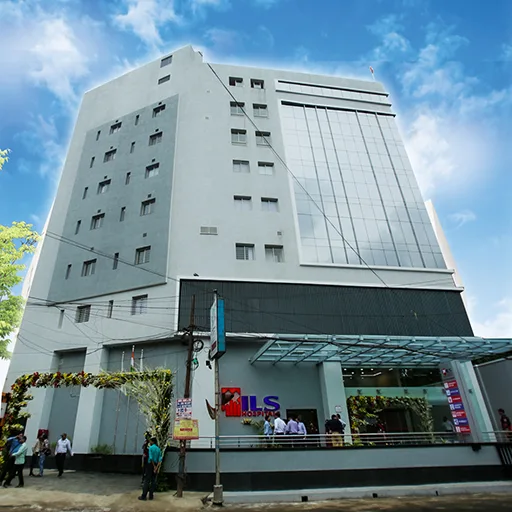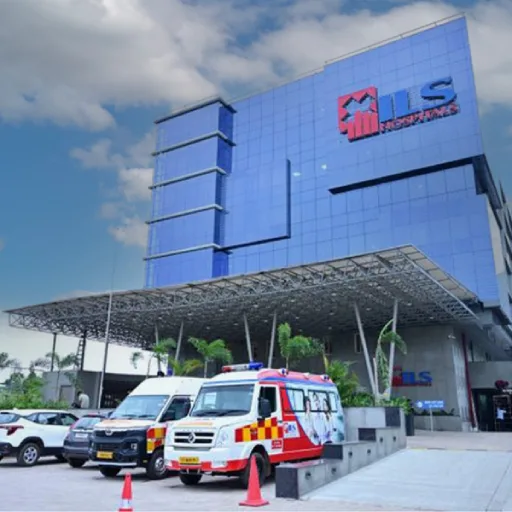Rediscover Freedom of Movement: Joint Replacement Surgery at ILS Hospitals
Joint replacement surgery is a transformative procedure designed to replace a damaged or deteriorated joint with an artificial joint (prosthesis). This procedure, frequently performed at ILS Hospitals, aims to alleviate pain, restore function, and significantly enhance the quality of life for individuals grappling with severe joint conditions.
Types of Joint Replacement Surgeries Offered
Hip Replacement: This surgery involves replacing a damaged hip joint with an artificial hip prosthesis. It is primarily utilized to address severe hip arthritis, hip fractures, or other conditions causing debilitating pain and loss of function.
Knee Replacement: This procedure focuses on replacing a diseased knee joint with an artificial knee prosthesis. It is often recommended for individuals struggling with severe knee arthritis, knee injuries, or conditions like rheumatoid arthritis.
Shoulder Replacement: Shoulder replacement surgery entails replacing a damaged shoulder joint with an artificial shoulder prosthesis. It is typically pursued to alleviate severe shoulder arthritis, rotator cuff tears, or fractures that haven’t healed properly.
Elbow Replacement: Elbow replacement surgery involves replacing a damaged elbow joint with an artificial elbow prosthesis. Although less common than hip or knee replacements, this procedure is performed for severe elbow arthritis or fractures.
Indications for Joint Replacement Surgery
Joint replacement surgery is considered when conservative treatments like medication, physical therapy, or assistive devices fail to provide adequate relief. Common indications for this surgery include:
- Chronic and debilitating joint pain significantly affecting daily activities, sleep, and overall quality of life.
- Inability to perform routine tasks or participate in activities due to joint stiffness, limited range of motion, and decreased strength.
- Development of joint deformities or malalignment, leading to further deterioration and functional impairment.
- Frequent joint dislocations or instability that can’t be effectively managed with conservative treatments.
- Ineffectiveness of non-surgical interventions like medication, physical therapy, injections, or other measures to provide sufficient pain relief and improve joint function.
Identifying the Ideal Candidate for Joint Replacement Surgery
While each case is unique, certain factors are often considered when determining the right candidate:
- Persistent Pain: Individuals experiencing chronic joint pain that significantly impacts their daily life and does not respond to conservative treatments are potential candidates.
- Functional Limitations: If joint pain and stiffness restrict mobility and hinder everyday activities, joint replacement may be considered.
- Quality of Life: If joint problems severely affect a person’s overall well-being, joint replacement surgery can help restore functionality.
- Failed Conservative Treatments: When non-surgical interventions fail to provide sufficient relief or improve joint function, surgery may be recommended.
- Overall Health: The candidate’s overall health and medical conditions are taken into account to evaluate their ability to tolerate surgery and undergo rehabilitation.
Preparing for Joint Replacement Surgery: A Comprehensive Approach
Preparing for joint replacement surgery at ILS Hospitals involves a series of crucial steps:
- Medical Evaluation: A thorough assessment, including a physical examination, medical history review, and imaging tests (X-rays, MRI), is conducted to evaluate the joint condition.
- Pre-operative Education: Patients receive detailed information about the procedure, including what to expect before, during, and after surgery. They are informed about potential risks, benefits, and post-operative rehabilitation.
- Medication Review: The surgeon reviews the patient’s current medications and provides guidance on which medications should be continued or temporarily stopped before surgery.
- Lifestyle Adjustments: Depending on the joint and individual circumstances, lifestyle adjustments may be recommended, such as weight management, smoking cessation, and dietary modifications.
- Pre-operative Exercises: Preparing the joint through exercises recommended by a physical therapist can help strengthen the muscles around the joint, improve flexibility, and optimize post-operative recovery.
The Surgical Procedure: Precision and Care
The joint replacement surgery involves several meticulous steps to ensure optimal outcomes:
- Anaesthesia: The surgical team administers appropriate anaesthesia to ensure the patient’s comfort during the procedure. Options include general anaesthesia (unconscious), regional anaesthesia (spinal or epidural), or a combination of both.
- Incision: The surgeon makes a precise incision over the affected joint, allowing access to the damaged joint surfaces.
- Joint Resurfacing: The damaged portions of the joint surfaces are skillfully removed, and the bone is prepared to accommodate the artificial joint components.
- Prosthesis Implantation: The artificial joint components, made of metal, plastic, or ceramic, are securely implanted into the joint. These components may be cemented or press-fit into the bone, depending on the patient’s specific needs.
- Wound Closure: Once the joint components are in place, the surgeon meticulously closes the incision using sutures or staples and applies dressings to promote healing.
Recovery and Follow-Up Care: Your Path to Progress
After joint replacement surgery, the patient’s recovery and rehabilitation process are vital for achieving optimal outcomes. Key aspects of this phase include:
- Hospital Stay: The duration of the hospital stay varies depending on the individual and the specific procedure. Generally, patients undergoing hip or knee replacement surgery can expect a stay of a few days.
- Pain Management: The medical team prescribes pain medication to manage post-operative pain. Physical therapy and other non-medication approaches may also be used to enhance pain control.
- Rehabilitation: Physical therapy typically commences shortly after surgery and continues as an outpatient program. Rehabilitation focuses on regaining joint mobility, strength, and function.
- Assistive Devices: Patients may require assistive devices like crutches, walkers, or canes during the initial phase of recovery. These aids help with mobility and ensure safety while the joint heals.
Complications and Risks: Navigating Your Journey Safely
While joint replacement surgeries are generally safe and successful, it’s essential to be aware of potential complications and risks, which may include:
- Infection: There is a small risk of developing a post-operative infection, which may require antibiotics or, in severe cases, additional surgeries to resolve.
- Blood Clots: Clots can form in the veins of the legs (deep vein thrombosis) or travel to the lungs (pulmonary embolism). Medications and preventive measures are used to minimize this risk.
- Prosthesis-related Issues: The artificial joint components can occasionally loosen, dislocate, or wear out over time, necessitating revision surgery.
- Nerve or Blood Vessel Damage: During the surgery, nearby nerves or blood vessels may be injured, leading to temporary or permanent complications.
- Joint Stiffness: Some patients may experience joint stiffness or limited range of motion after surgery. Physical therapy can help address this issue.
Frequently Asked Questions (FAQs): Addressing Your Concerns
Q1. How long does a joint replacement surgery last?
The duration of the surgery depends on the joint being replaced and the complexity of the case. On average, joint replacement surgeries take around 1 to 3 hours.
Q2. Will I be able to resume my regular activities after joint replacement surgery?
Most individuals experience significant improvement in pain relief and functionality after joint replacement surgery. While activities may need to be modified initially, many patients can eventually resume their regular activities, including low-impact exercises and recreational sports.
Q3. How long is the recovery period after joint replacement surgery?
Recovery periods can vary, but patients often see significant improvements within the first few weeks to months. However, complete recovery and optimal outcomes may take several months to a year.
Q4. Are there any age restrictions for joint replacement surgery?
There is no specific age restriction for joint replacement surgery. The decision is based on the individual’s overall health, joint condition, and the potential benefits outweighing the risks.
Q5. How long do joint replacements typically last?
The lifespan of joint replacements varies depending on several factors, including the patient’s activity level, overall health, and the type of prosthesis used. In general, modern joint replacements can last for 15-20 years or longer.
Q6. Can joint replacement surgery be performed using minimally invasive techniques?
Minimally invasive techniques may be used in some cases, allowing for smaller incisions and potentially shorter recovery times. However, not all patients are suitable candidates for minimally invasive procedures, and the surgeon will determine the best approach based on individual circumstances.
Q7. Are there alternatives to joint replacement surgery?
In some cases, alternative treatments like medication, physical therapy, injections (such as corticosteroids or viscosupplementation), or arthroscopic procedures may be considered before joint replacement surgery. These options are usually explored first, and surgery is recommended when non-surgical treatments fail to provide sufficient relief.
Q8. Can both joints be replaced simultaneously?
Simultaneous joint replacement surgery, where both joints are replaced during a single operation, is possible in some cases. However, the decision depends on various factors, including the patient’s overall health, age, and the surgeon’s recommendation.
Q9. Can joint replacement surgery be performed as an outpatient procedure?
While some surgeries, such as arthroscopic procedures, can be performed on an outpatient basis, most joint replacement surgeries require a hospital stay for proper monitoring and post-operative care.
Q10. Can I have a second joint replacement surgery if needed?
In cases where a joint replacement wears out or becomes damaged over time, revision surgery may be necessary. Revision surgeries are typically more complex than the initial joint replacement but can provide relief and restore function.
At ILS Hospitals, we prioritize your mobility, comfort, and quality of life. If you’re considering joint replacement surgery or have any questions, our dedicated team of healthcare professionals is here to guide you every step of the way.













































